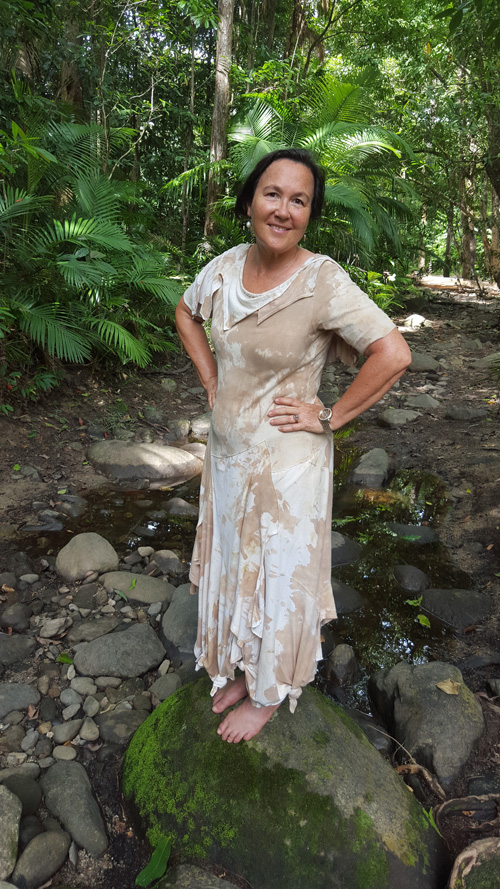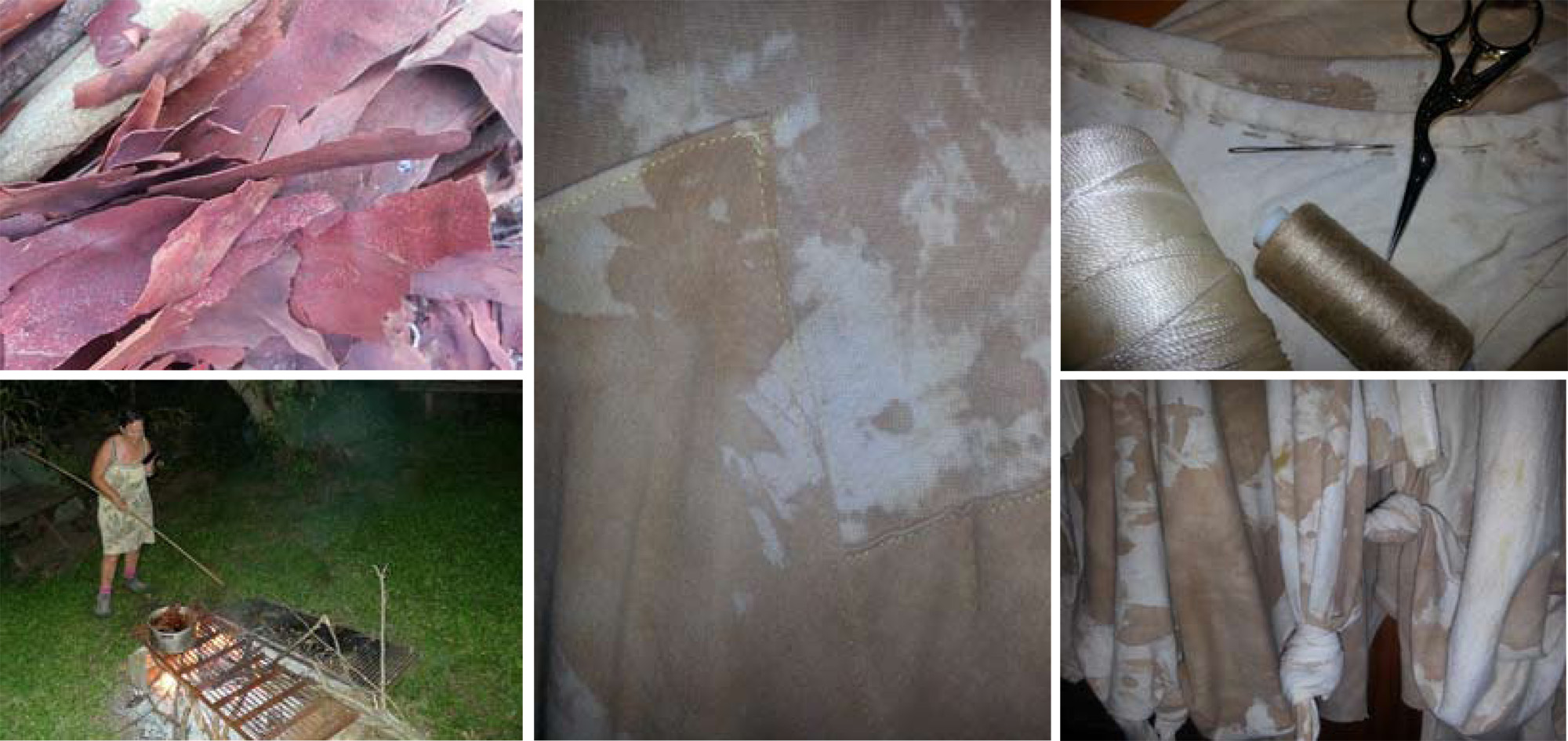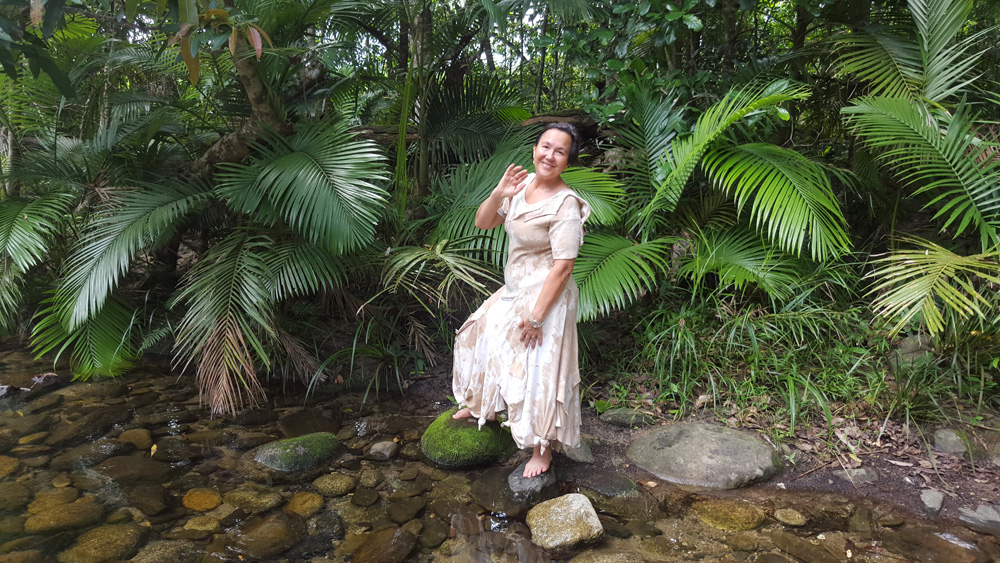
Jane Milburn in eco-dyed t-shirt dress. Photo by Darcy Milburn at South Mossman River in north Queensland
Clothing is as essential as food for our health and wellbeing because clothes do for us on the outside what food does inside – they nourish, warm, and engage body and soul. What we choose to wear impacts how we feel and how we present to the world.
As conscious eaters are now aware of sourcing fresh whole food and returning to the kitchen – conscious dressers are engaging in the process of learning where and how their clothes are made. Our choices have profound influence – yet sometimes we are too busy to think much about them.
Fast, processed food has had a dramatic impact on health across the population in recent decades and similarly the transformational shift to fast, manufactured clothing is having impacts we are only now coming to understand.
Without doubt there are thousands of wonderful designers and billions of beautiful clothes available for purchase through the trillion dollar global garment industry. Yet this industry flourishes through the hard work of garment workers in developing countries who may, or may not, be paid appropriately for their efforts. Read about the global garment industry here from Clean Clothes Campaign.
Meanwhile in Australia and other developed nations, two generations have largely missed the opportunity to learn to sew and 70% of millennials don’t even know how to sew on a button.
The Slow Clothing Project is bringing awareness to the way we dress and enabling conversation about the story and substance, not just the style, of the garments we choose to wear. We are learning how the revolving door of fashion generates waste, exploitation, dissatisfaction and disempowerment. We are part of the Fashion Revolution, a global movement of people bringing change to the world through the garments we choose to wear.
We want to be certain that our clothes are ethical and sustainable, and have a positive story to tell about the way they were made. One way to be certain is to engage in the making process ourselves.
We have sought individual makers of different ages, stages and skills to create a garment that is handmade, natural and as local at it can be. More than 100 people around Australia expressed interest in the project, so the plan is to create a digital collection of garments on this website as well as a physical collection of 40 garments for subsequent displays.
The clothing we choose to wear is a simple way of bringing creativity into daily life. Everyone can be creative when they follow their heart and allow themselves to be inspired by difference, embrace imperfection, and dedicate some time and space to the mindfulness of making.
At this time in our history, when climate change is an acknowledged reality and countries are committed to slowing global warming, we can each make a small contribution by changing the way we consume the Earth’s limited resources. It starts with the everyday choices you make in buying, caring for and shedding your clothes.
Maker – Jane Milburn
The first story we share is from Textile Beat founder Jane Milburn. Jane has drawn together the threads of her upbringing, education and career into purposeful work as an upcycler and champion of a more sustainable clothing culture. Jane learned to sew from her mother Elizabeth Capon and believes sewing is a life skill that enables you to mend, care for, and adjust clothes, as well as make simple garments should you want to. She made most of her own clothes while working in various communication roles and raising three children now all successful young professionals. Jane prefers clothing made from natural fibres, considers her wardrobe sustainable because she either makes/modifies existing garments herself or sources pre-loved quality investment pieces.
Jane created this eco-dyed cotton dress from five discarded t-shirts. After dyeing the white shirts in her backyard using bark and onion skins, she chose the shirt with the heaviest weave to form the bodice. She then cut the other four shirts (diagonally across the front to the neck then across the shoulders of each), overlapped, pinned and draped these pieces (they hang from the diagonal cut) to form the skirt which was then machine stitched to the bodice t-shirt. This process was free-form and involved pinning while on the body and not possible to demonstrate with photographs. The random hemline was adjusted by cutting off or knotting the longer pieces, with the offcuts were then used to fill in the shorter sections. After trimming away the neck on the bodice tshirt, she stitched offcuts from the hem to form a creative neckline which was secured by two rows of hand stitching.

